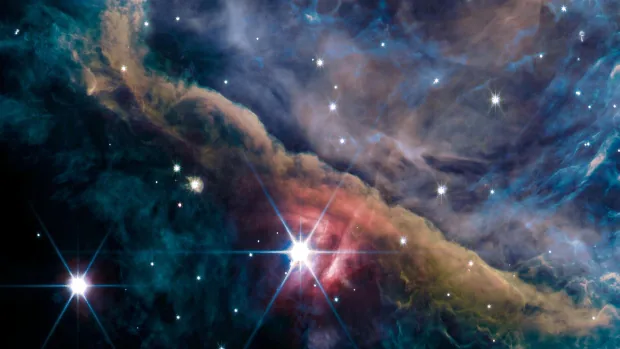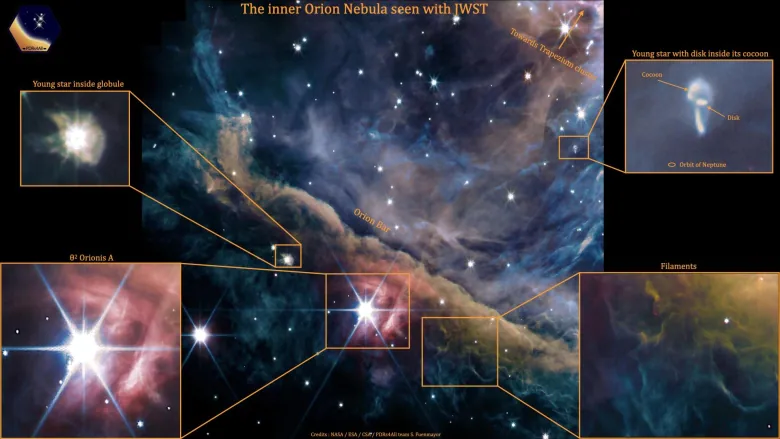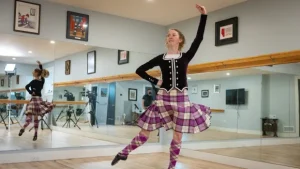
More than 1,300 light-years from Earth lies a stunning area of dust and gas called the Orion Nebula. On Monday, a team of astronomers from around the world released the most detailed image ever of this rich star-forming region taken by the James Webb Space Telescope (JWST).
Els Peeters, an astronomer and professor at Western University in London, Ont., who is one of the principal investigators for the JWST observing program known as PDRs4AlI, said she’s thrilled by the image.
“It’s just the amazing detail, how sharp the images are, all this filamentary structure,” she told CBC News.
The composite image — which used several filters — was taken using JWST’s NIRCam instrument. It shows a seemingly wind-swept region of blue gas, a bright star lighting up gas around it and, most prominently, an area of dense dust and gas, known as the Orion Bar. But most interesting are the filaments, globules and young stars.

While the region — only a small part of the larger Orion Nebula, which is one of the closest star-forming regions — has been studied using other telescopes, most notably the Hubble Space Telescope, JWST sees in infrared light that is able to see beyond optical light, peering through thick dust, revealing what the human eye can’t see that is hidden.
It’s this that Peeters is most interested in exploring. Her team has been studying the region since 2017 and has been eagerly awaiting the new image. Previously, her team had used NASA’s Spitzer space telescope, which can also see in infrared — but not nearly with as much resolution as JWST can provide.
But this is more than just a pretty picture. It’s part of a study to explore how stars and planets form, shedding more light on how our own solar system and planet formed. It’s looking to our origin.
“We have never been able to see the intricate fine details of how interstellar matter is structured in these environments, and to figure out how planetary systems can form in the presence of this harsh radiation,” Emilie Habart, an associate professor at Institut d’Astrophysique Spatiale in Paris, said in a statement.
![Credit: NASA, ESA, CSA, PDRs4All ERS Team; image processing Olivier Berné. Credit for the HST image: NASA/STScI/Rice Univ./C.O’Dell et al. – Program ID: PRC95-45a. Technical details: The HST image used WFPC2 mosaic.This composite image uses [OIII] (blue), ionized hydrogen (green), and [NII] (red).](https://skynews.icu/wp-content/uploads/2022/09/1663537132_420_Newly-released-image-from-James-Webb-telescope-reveals-Orion-Nebula.jpg)
Meanwhile, Peeters said that massive, young stars — and even those already in star-forming regions — give off intense ultraviolet radiation in the surrounding clouds. This can change not only the shape of the cloud but also its chemical composition. She and her team want to understand how that works and how it could affect further stellar and planetary formation.
Some interesting finds in this image are also protostars, which are stars that are just beginning to form.
“You can see in Orion a blazing star nursery there, plenty of young stars. We [also] see a few protostars in this image. And so eventually, over time in some of these disks will form planets,” Peeters said, but added, “Probably not in our lifetime.”
This understanding of how gases and radiation play such an integral role in the formation of stars doesn’t end with this new image. The teams are still waiting for spectroscopic data, which will reveal the specific chemical elements contained in and around the region.
“If you want to understand the star formation in the universe, and your planet formation, you need to understand the basics,” Peeters said. “And so the Orion Bar is kind of a laboratory: You go there, find out what’s going on and then you apply it to other areas.”
And it’s also part of answering the big questions, she said.
“Where do we come from? Are we alone?” she said. “I think, in that sense, understanding star formation, planet formation is part of that puzzle.”

